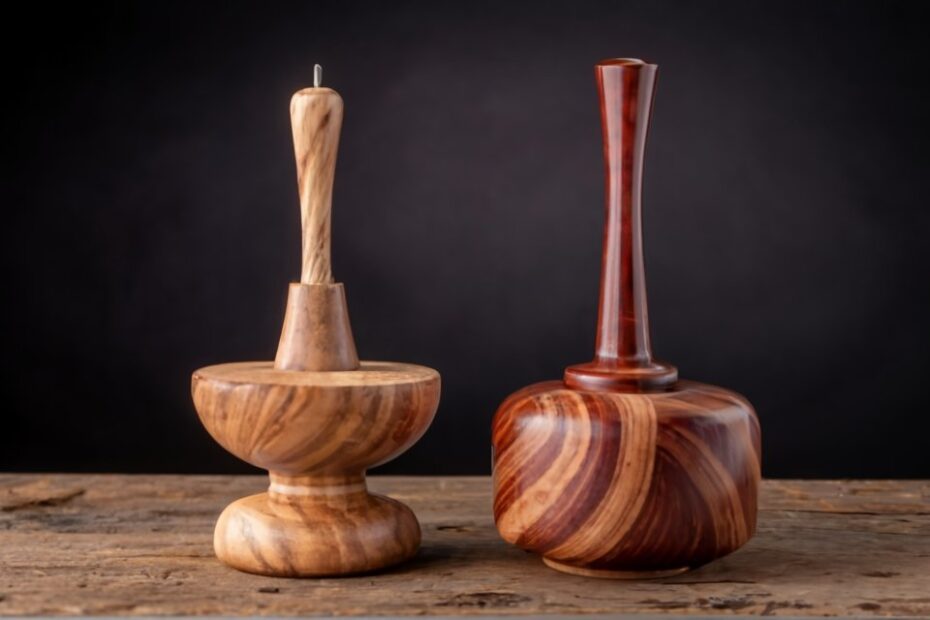You may be wondering, why should I care about the difference between spindle turning and bowl turning? After all, aren’t they both just woodworking techniques?
Well, my friend, while it’s true that both involve the art of turning wood on a lathe, there are some key distinctions that make each method unique. From the types of projects you can create to the tools and techniques used, understanding the difference between spindle turning and bowl turning can open up a whole new world of possibilities for your woodworking endeavors.
So, buckle up and prepare to explore the fascinating world of woodturning, where creativity meets craftsmanship in the most captivating way.
Types of Woodturning Techniques
When it comes to woodturning techniques, understanding the difference between spindle turning and bowl turning is essential.
Spindle turning involves shaping a piece of wood while it spins on a lathe. This technique is commonly used to create items such as table legs, chair spindles, and tool handles. The wood is mounted between the headstock and tailstock of the lathe, allowing it to be turned and shaped with various cutting tools.
On the other hand, bowl turning focuses on creating hollow forms such as bowls, vases, and goblets. This technique requires a different approach, as the wood is mounted on a faceplate or chuck and turned from the outside to the inside. Hollow form turning is a specialized skill that requires careful attention to grain orientation, tool control, and the use of hollowing tools to create the desired shape and thickness of the vessel walls.
Segmented turning is another technique that can be employed in both spindle turning and bowl turning. This technique involves creating intricate patterns and designs by gluing together multiple pieces of wood to form a larger blank. The segmented blank is then mounted on the lathe and turned to create the final shape. This technique allows for endless possibilities in terms of design and creativity.
Differences in Project Types
There are distinct differences in the types of projects that can be created through spindle turning and bowl turning techniques. Understanding these differences will allow you to choose the appropriate method for your woodworking project.
Benefits and limitations of spindle turning:
- Spindle turning is ideal for creating long, slender objects such as table legs, chair spindles, and candlesticks. Its main advantage is its ability to produce repetitive shapes quickly and accurately.
- However, spindle turning has limitations when it comes to creating complex curves or hollow forms. It isn’t suitable for creating bowls or vessels with large diameters.
Creative possibilities in bowl turning:
- Bowl turning opens up a world of creative possibilities. With this technique, you can create bowls, vases, platters, and other hollow forms.
- Bowl turning allows you to work with irregular shapes, explore different rim designs, and experiment with various surface textures and decorative techniques.
- Additionally, bowl turning offers the opportunity to showcase the natural beauty of the wood grain, as the interior of the bowl can be carved to reveal stunning patterns and figure.
Tools and Equipment for Spindle Turning
To properly engage in spindle turning, you’ll need the appropriate tools and equipment. Safety precautions should always be a top priority when working with these tools. When turning spindles, it’s important to wear safety glasses or a face shield to protect your eyes from flying debris. Additionally, make sure your lathe is stable and securely fastened to the workbench.
Now let’s talk about the tools you’ll need. The most essential tool in spindle turning is the roughing gouge, which is used to remove large amounts of material quickly. A skew chisel is another important tool that’s used for shaping and smoothing the spindle. You’ll also need a parting tool for cutting the spindle off from the lathe once you’re finished.
In terms of equipment, a lathe is obviously necessary for spindle turning. Make sure to choose a lathe that’s appropriate for your project size and requirements. To hold the spindle securely in place, you’ll need a drive center and a tailstock center. A live center can also be useful for additional support.
Now that you have an understanding of the tools and equipment needed for spindle turning, let’s discuss some common spindle turning projects. These can include candlesticks, table legs, tool handles, and even decorative finials. Remember to always prioritize safety and practice proper technique when engaging in spindle turning.
Tools and Equipment for Bowl Turning
For bowl turning, having the appropriate tools and equipment is crucial to ensure a successful and safe turning experience. Here are the essential tools and equipment you need:
- Lathe: A sturdy and reliable lathe is the foundation of bowl turning. Look for a lathe with a powerful motor and a solid construction to handle the demands of turning large bowls.
- Bowl Gouges: Bowl gouges are specialized tools designed for shaping and hollowing out bowls. They’ve a deep flute and a thick shaft to provide stability and control while cutting. Make sure to have a variety of bowl gouges with different sizes and grinds to accommodate various bowl sizes and wood types.
- Faceplate or Chuck: A faceplate or chuck is used to secure the bowl blank to the lathe. It’s essential to choose a secure and reliable method of mounting the bowl blank to prevent accidents and ensure stability throughout the turning process.
Safety precautions for bowl turning:
- Always wear protective gear, including a face shield, goggles, and a dust mask to protect yourself from flying wood chips and dust.
- Take regular breaks to avoid fatigue and maintain focus on the task at hand.
- Keep your work area clean and free of clutter to prevent accidents.
Common mistakes to avoid in bowl turning:
- Rushing the turning process, which can lead to uneven surfaces and structural weaknesses.
- Neglecting to secure the bowl blank properly, resulting in the blank shifting or flying off the lathe.
- Failing to use the appropriate cutting techniques, such as proper tool presentation and cutting angles, which can result in tear-outs and rough surfaces.
Techniques and Methods Used in Each Method

Spindle turning and bowl turning are two distinct techniques in woodturning that require different methods and approaches. When it comes to safety precautions, both techniques demand close attention and adherence to safety guidelines.
Eye protection is crucial, as wood chips and debris can fly off the lathe at high speeds. It’s also important to secure the workpiece properly, using a chuck or faceplate to minimize the risk of it flying off the lathe. Additionally, proper use of tools and maintaining a safe distance between your body and the spinning wood is essential.
In terms of finishing techniques, spindle turning typically involves sanding the workpiece while it’s still on the lathe. This allows for easy access to all areas of the spindle.
Bowl turning, on the other hand, often requires removing the bowl from the lathe to apply finishes such as lacquer or wax. This allows for better control and coverage of the surface.
Conclusion
In conclusion, while spindle turning and bowl turning are both woodturning techniques, they differ in terms of project types, tools and equipment used, and techniques employed.
Spindle turning focuses on creating long, cylindrical objects such as table legs.
Bowl turning, on the other hand, is used to create, well, bowls.
Each method requires specific tools and techniques to achieve desired results.
So whether you’re looking to create a spindle or a bowl, understanding the differences between these two techniques is essential for any woodturning enthusiast.
FAQ’s
-
What is the main difference between spindle turning and bowl turning?
The main difference is that spindle turning involves shaping a piece of wood while it spins on a lathe to create items such as table legs, while bowl turning focuses on hollowing out wood to create bowls, vases, and other vessels.
-
What kind of projects can you make with spindle turning?
Spindle turning allows you to create long, slender turned objects such as table and chair legs, tool handles, candlesticks, and other decorative items like finials.
-
What tools do you need for bowl turning?
The essential tools for bowl turning include a sturdy lathe, specialized bowl gouges for hollowing out bowls, a reliable faceplate or chuck for mounting bowl blanks, and proper safety gear like a face shield and dust mask.
-
What safety precautions should you take with bowl turning?
It’s crucial to always wear protective gear like a face shield and respirator when bowl turning. Also make sure to properly secure bowl blanks, avoid fatigue, keep your work area clean, and maintain focus on the spinning workpiece to prevent accidents.
-
What is the benefit of segmented turning?
Segmented turning allows for creating intricate patterns and designs by gluing together separate pieces of wood. This opens up creative possibilities and allows you to showcase exotic wood grain patterns in your turned projects.
-
When is sanding and finishing done in spindle turning vs bowl turning?
Spindle turning involves sanding the spindle while it’s still mounted on the lathe for easy access. But bowl turning typically requires removing the bowl to apply finishes, allowing for better control and coverage of the interior surfaces.

I’m James Brown, the founder and editor of DIYINUSE.COM. I have over 15 years of hands-on woodworking and DIY experience that I share through tips and project inspiration on my website. When I’m not working on home improvement projects or creating content for the site, I enjoy spending time outdoors hiking and fishing. I’m always looking to expand my creativity and DIY skills by learning new techniques.
